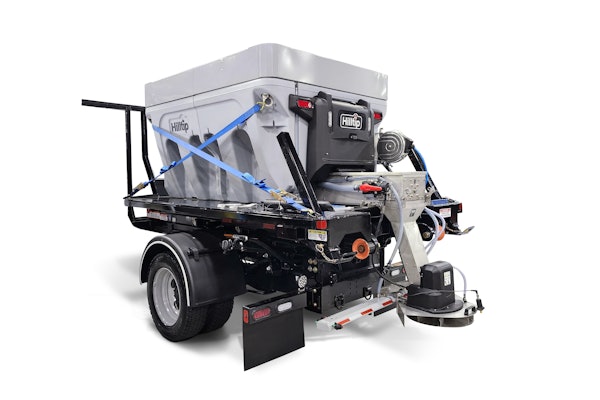At the national level, demand for residential fencing has taken a nosedive with housing construction and prices, but turning an extra profit by including fence work in your landscapes is still possible.
Fence construction around schools, hospitals, industrial plants, parks and other government properties is up significantly, says Mark Meek, president of sales and marketing, Ameristar Fence Products, one of the largest fencing manufacturers in the United States.
But the news for residential isn’t all bad. The negative impact of the housing bubble burst in the populous states of California, Arizona, Nevada, Georgia and Florida is weighing down the rest of the nation, Meek says. In areas such as Oklahoma, Missouri, Kansas and Texas the market is growing.
Joe Densieski, president of Nu Green Landscaping in Riverhead, New York, on Long Island, says he’s been building more fences in recent years – mainly because 9/11 and high gas prices have driven up pool construction. “People want to stay home more instead of traveling,” he says. “Everybody’s turning their backyard into their own retreat. They’re putting in pools, and once you have a pool, you have to have fencing to code. That’s why almost every landscaping job I do now includes fencing.”
Going beyond code requirements by fencing both the perimeter of the yard and the pool is a trend in central Georgia, says Mike Giles, owner of Southern Structures, a fencing company based in Warner Robins. Double fencing allows parents to feel comfortable leaving their children outside while they grill dinner nearby, for instance, because they know the kids are in the backyard, but can’t fall in the pool, he says.
If you can’t build it, maintain it
In markets where new residential construction – and thus new fence construction – is at a standstill and rising fuel and food prices are keeping homeowners from replacing old fences, opportunities for repair and maintenance abound. Giles says his firm’s maintenance work is up 50 percent compared with two years ago.
While demand for low-maintenance metal and vinyl fencing has surged during the past five years, the majority of residential fences in the United States are still wooden and require regular maintenance to look their best. Property owners who would have asked Giles, who specializes in wood fencing, to tear down and replace a weathered fence a couple years ago are now asking him to restore it. “A lot of people are cleaning old fences, staining and repairing them to make them look new for a lot less money,” he says.
Discoloration of wooden fencing is the result of mildew and exposure to the sun and elements. In most cases, if you pressure wash them with a deck wash, “that board will come back to life almost like it was the day it was put up,” Giles says. The repair work his company does often involves adding metal posts and frames to sagging gates, allowing them to swing like new again.
What’s popular
After 9/11, the newly formed Department of Homeland Security mandated improved
security at high-risk facilities such as chemical plants and refineries, large banks, data centers, courthouses and FBI buildings. Much of this improvement is still being done, Meek says, and combined with strong spending on nonresidential and government construction, is boosting fence installation in all sectors except residential. Landscape contractors are most likely to benefit from school, university, hospital, park, municipal and county projects, Meek says.
The trend with this kind of fencing is a shift from chain-link to ornamental metal fences. Meek says there are two reasons for this – better security and enhanced property value.
Fencing Trends
Here are a few of the current crazes in residential fencing:
Vinyl and ornamental metal fencing in the residential market. Demand for these is growing at the fastest rate. Ameristar’s distributors who sell wooden fencing aren’t selling more of it than they were six or seven years ago, but they are selling more vinyl and ornamental metal, Meek says. “It just may be a matter of discretionary income or the result of a lot of baby boomers moving into retirement communities, but the big trend is maintenance-free,” he says.
Bronze-colored ornamental metal fencing. Ninety percent of ornamental metal fencing has been black for 10 years, Meek says, but among the remaining 10 percent bronze has replaced white.
Around pools, ornamental metal fencing with a flat top rail. Parents and grandparents don’t have to worry about children hurting themselves on sharp points, Densieski says.
For his own pool, Giles built a stained-black wooden fence that mimics the look of metal – for about $18 per square foot instead of $35. He put a photo of it on his Web site and gets lots of requests for similar fences.
Wooden fences with clean-cut lines. Because of the price point advantage and because some homeowner associations require it, the market for wooden fencing remains strong in certain areas. Giles says the styles homeowners prefer are the 6-foot by 6-foot panel with 2 by 6-foot at the top and bottom, giving the panels a picture-frame look, and the 6-foot by 6-foot panel with a smooth arch at the top.
Honey gold, cedar and desert sand stain. Honey gold is the color of new pine, only a bit brighter. “All the waves, the grain of the wood, the knots – it just makes them pop,” Giles says. He uses desert sand in neighborhoods where houses are brown brick with light tan siding the color of the stain.
A heavy application of quality stain can last seven to 10 years, Giles says. You can pay $80 to $150 for five gallons of stain, and he recommends buying the most expensive product. “Always get the best; don’t skimp,” he says. “A fence is a major investment and you want to protect your client’s investment.”






